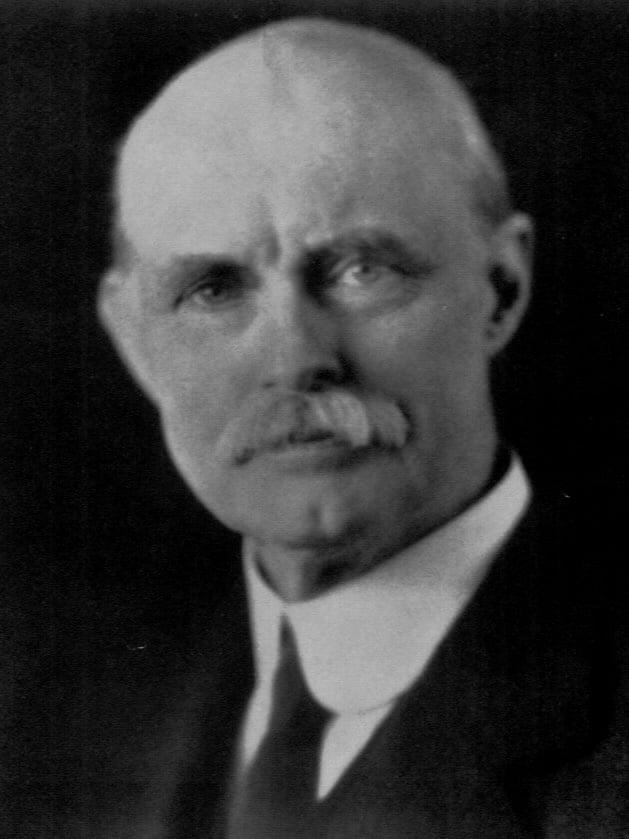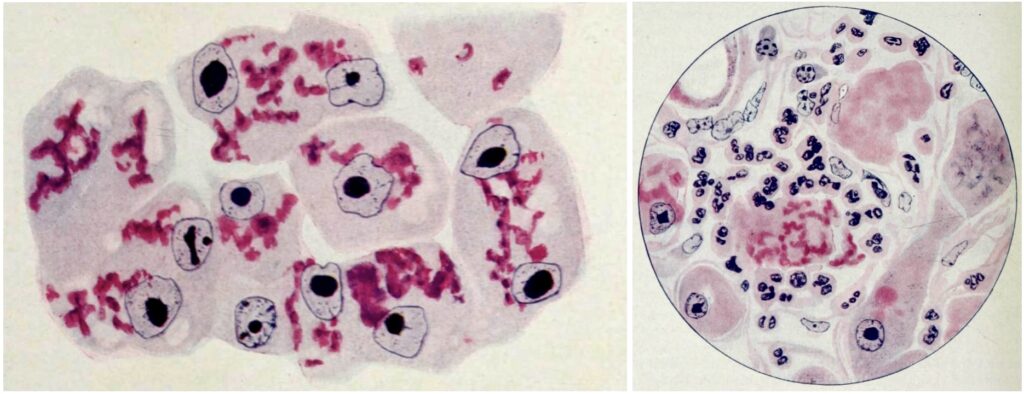Frank Mallory

Frank Burr Mallory (1862-1941) was an American pathologist
Mallory was an American pathologist whose meticulous investigations reshaped early twentieth-century understanding of disease. Based for most of his career at Harvard and the Boston City Hospital, he combined clinical observation with innovative histological methods, producing landmark descriptions in infectious disease, liver pathology, and neoplastic classification. His work was distinguished by clarity of style, elegant illustration, and a relentless pursuit of diagnostic precision.
Mallory is perhaps best remembered for his eponymous contributions. Mallory’s hyaline, the cytoplasmic inclusions in hepatocytes of alcoholic cirrhosis later known as Mallory bodies and a suite of stains (trichrome, PTAH, phloxine, iodine) that transformed pathological diagnosis. By exploiting the affinities of new aniline dyes, he created reproducible preparations that revealed the microscopic architecture of connective tissue, muscle, and neuroglia with unprecedented clarity. These stains not only facilitated clinical practice in his own era but also remain embedded in laboratory protocols today.
Beyond technique, Mallory’s research spanned typhoid, diphtheria, scarlet fever, measles, nephritis, and tumor pathology. His Principles of Pathologic Histology (1914; 2nd ed. 1918) structured pathology into a coherent discipline for American medicine. As teacher, mentor, and journal editor, he was instrumental in establishing pathology as a rigorous scientific specialty in the United States, shaping generations of clinicians and researchers. His legacy is both eponymous and enduring—etched into the stains, structures, and textbooks that continue to inform medical practice.
Biographical Timeline
- 1862 – Born November 12 in Cleveland, Ohio, son of George Burr Mallory and Anne (Faragher) Mallory
- 1886 – Graduated A.B., Harvard College
- 1890 – Graduated M.D., Harvard Medical School
- 1891 – Assistant in histology at Harvard Medical School; assistant to William T. Councilman at Boston City Hospital; postgraduate studies in Europe with Hans Chiari (Prague) and Ernst Ziegler (Freiburg)
- 1892 – Published first scientific paper
- 1893 – Married Persis McClain Tracy; two sons, Tracy Burr Mallory
(1896–1951) (later Chief of Pathology at MGH) and George Kenneth Mallory (1900-1986) - 1894 – Instructor in pathology, Harvard Medical School
- 1896 – Assistant professor of pathology, Harvard
- 1897 – With James Homer Wright, published Pathological Technique, a manual that became the standard reference in histology and bacteriology (8 editions)
- 1901 – Associate professor, Harvard
- 1908 – Appointed Pathologist-in-Charge, Boston City Hospital
- 1910 – President, American Association of Pathologists and Bacteriologists
- 1911 – Published seminal paper on cirrhosis, describing eosinophilic hepatocyte inclusions (later named Mallory bodies)
- 1914 – Published Principles of Pathologic Histology
- 1923–1925 – Editor, Journal of Medical Research
- 1925–1940 – Founding editor, American Journal of Pathology
- 1928 – Appointed full professor of pathology, Harvard; awarded honorary Sc.D., Tufts University
- 1932 – Retired at age 70; Boston City Hospital opened the Mallory Institute of Pathology in his honour; awarded honorary Sc.D., Boston University
- 1935 – Awarded the Kober Medal for distinguished service in pathology
- 1939 – Published final scientific paper
- 1941 – Died September 27 in Brookline, Massachusetts, aged 78
Medical Eponyms
Mallory Bodies (1911)
Mallory bodies (also called Mallory–Denk bodies) are intracytoplasmic eosinophilic inclusions found in hepatocytes, typically associated with alcoholic liver disease, Wilson disease, primary biliary cholangitis, Zieve syndrome and hepatocellular carcinoma. Histologically, they consist of damaged intermediate filaments (cytokeratin 8/18).
1911 – Frank Burr Mallory first described distinctive cytoplasmic inclusions in hepatocytes of patients with alcoholic cirrhosis. These eosinophilic hyaline aggregates, later termed Mallory’s hyaline (or Mallory bodies), became a hallmark of alcoholic hepatitis and related liver diseases.
In the chronic, progressive, alcoholic type of cirrhosis there occurs a peculiar form of necrosis of the liver cells, which seems to be characteristic of it. The cytoplasm of the cells first undergoes a degenerative change in consequence of which an irregular, coarse, hyaline meshwork appears in it… After the hyaline change has reached a certain degree of intensity the cells are surrounded and invaded by numerous polymorphonuclear or endothelial leukocytes, which dissolve the cells, the hyaline reticulum last, and thus bring about their disappearance
Mallory 1914

Left: Fig. 385. Liver. Alcoholic cirrhosis. Hyaline droplets appearing in cytoplasm of liver cells and fusing together.
Right: Fig. 386. Liver. Alcoholic cirrhosis. Liver cells containing hyalin undergoing necrosis and attracting chiefly polymorphonuclear leukocytes. Mallory 1914
Initially thought to be unique to alcohol-related disease, Mallory bodies are now known to occur in a wide spectrum of conditions including non-alcoholic steatohepatitis (NASH), Wilson’s disease, copper toxicosis, primary biliary cirrhosis, Zieve syndrome and hepatocellular carcinoma.
Modern pathology has revealed that their main constituents are keratins 8 and 18, together with ubiquitin and p62, reflecting disturbances in protein folding, stress responses, and proteasome overload.
1975 – A major turning point with Helmut Denk, Franz Gschnait, and Klaus Wolff reporting the experimental production of Mallory bodies in mice treated long-term with griseofulvin
The experimental production of hepatocellular hyalin identical with human alcoholic hyalin both light and electron microscopically in long-term griseofulvin-treated mice is described. Moreover, the results conclusively disprove the specificity of Mallory alcoholic hyalin for alcohol-induced liver cell damage
Denk 1975
This landmark study demonstrated that Mallory bodies were not specific to alcohol, but rather a generic marker of hepatocellular stress and injury. In recognition of Denk’s pivotal contributions, the term Mallory–Denk bodies (MDBs) was formally proposed in 2007 by Zatloukal et al
Mallory’s Stains
Frank Burr Mallory developed a series of histological stains that became foundational to diagnostic pathology. His techniques, often based on the selective affinities of aniline dyes and tungstic acids, allowed clear visualization of connective tissue, neuroglia, muscle fibers, and pathological inclusions.
- Mallory’s Trichrome Stain (aniline blue/triple stain): connective tissue blue; muscle and neuroglia red; elastin pink/yellow.
- Mallory’s Phosphotungstic Acid Haematoxylin (PTAH) Stain: nuclei, mitochondria, fibrin, and striated muscle stain blue; elastin and cartilage appear in yellow–brown.
- Mallory’s Actinomyces Stain: highlights mycelia (blue) and clubs (red), aiding in bacterial diagnosis.
- Mallory’s Phloxine Stain: selectively stains hyaline red, useful in distinguishing hyaline degeneration.
- Mallory’s Iodine Stain: amyloid appears red–brown with iodine, shifting to violet/blue after sulfuric acid.
- Mallory’s Collagen Stain: connective tissue stain using phosphomolybdic or phosphotungstic acid.
These methods became routine in pathology labs worldwide and remain referenced in modern histological protocols, demonstrating Mallory’s lasting influence.
Major Publications
- Mallory FB. Wright JH. Pathological technique; a practical manual for the pathological laboratory. 1897
- Mallory FB. Epidemic cerebro-spinal meningitis and its relation to other forms of meningitis. 1898
- Councilman WT, Mallory FB, Pearce RM. A study of the bacteriology and pathology of two hundred and twenty fatal cases of diphtheria. 1900
- Mallory FB. A contribution to staining methods: I. A differential stain for connective tissue fibrils and reticulum. II. Chloride of iron-hematoxylin for nuclei and fibrin. III. Phosphotungstic acid-hematoxylin for neuroglial fibers. The Journal of Experimental Medicine, 1900 Oct 1;5(1):15-20
- Mallory FB. Pathological technique; a practical manual for workers in pathological histology and bacteriology. 1901
- Mallory FB. The results of the application of special histological methods to the study of tumors. The Journal of Experimental Medicine, 1908 Sep 5;10(5):575-93.
- Mallory FB. Cirrhosis of the liver. Five different types of lesions from which it may arise. Bulletin of the Johns Hopkins Hospital. 1911; 22(240): 69-75. [Mallory bodies]
- Mallory FB, Hornor AA, Henderson FF. The Relation of the Bordet-Gengou Bacillus to the Lesion of Pertussis. J Med Res. 1913 Mar;27(4):391-398.3.
- Mallory FB. The principles of pathologic histology. 1914
- Mallory FB, Parker F. Reticulum. Am J Pathol. 1927 Sep;3(5):515-526.21.
- Mallory FB. Phosphorus and Alcoholic Cirrhosis. Am J Pathol. 1933 Sep;9(5):557-568.13.
References
Biography
- Leary T. Frank Burr Mallory and the Pathological Department of the Boston City Hospital. Am J Pathol. 1933;9(Suppl):659-672.3
- H E M. Dr. Frank Burr Mallory’s Seventieth Birthday. Can Med Assoc J. 1934 Feb;30(2):190
- Parker F. Frank Burr Mallory. Am J Pathol. 1941 Nov;17(6):i4-786.
- Parker F Jr. Frank Burr Mallory. Science. 1941 Nov 7;94(2445):430-1.
- Haythorn SR. Frank Burr Mallory. 1862–1941. The Journal of Pathology and Bacteriology 1942; 54(2): 263-267
- van den Tweel JG. Mallory, Frank Burr (1862–1941) In: Pioneers in Pathology. 2017: 356-357
Eponymous terms
- Denk H, Gschnait F, Wolff K. Hepatocellar hyalin (Mallory bodies) in long term griseofulvin-treated mice: a new experimental model for the study of hyalin formation. Lab Invest. 1975 Jun;32(6):773-6.
- Prichard R. Selected items from the history of pathology. Frank Burr Mallory. Am J Pathol. 1979 May;95(2):422
- Jensen K, Gluud C. The Mallory body: morphological, clinical and experimental studies (Part 1 of a literature survey). Hepatology. 1994 Oct;20(4 Pt 1):1061-77.
- Jensen K, Gluud C. The Mallory body: theories on development and pathological significance (Part 2 of a literature survey). Hepatology. 1994 Nov;20(5):1330-42.
- Zatloukal K, French SW, Stumptner C, Strnad P, Harada M, Toivola DM, Cadrin M, Omary MB. From Mallory to Mallory-Denk bodies: what, how and why? Exp Cell Res. 2007 Jun 10;313(10):2033-49.
- Louis DN, O’Brien MJ, Young RH. The flowering of pathology as a medical discipline in Boston, 1892-c.1950: W.T. Councilman, FB Mallory, JH Wright, SB Wolbach and their descendants. Mod Pathol. 2016 Sep;29(9):944-61.
- Kurtovic E, Zubair M. Mallory Bodies. 2025 May 4. In: StatPearls
Eponym
the person behind the name
BM BCh, Oxford University. Currently training in Australia. Career interest in Hepatology and Emergency Medicine
BA MA (Oxon) MBChB (Edin) FACEM FFSEM. Emergency physician, Sir Charles Gairdner Hospital. Passion for rugby; medical history; medical education; and asynchronous learning #FOAMed evangelist. Co-founder and CTO of Life in the Fast lane | On Call: Principles and Protocol 4e| Eponyms | Books |

